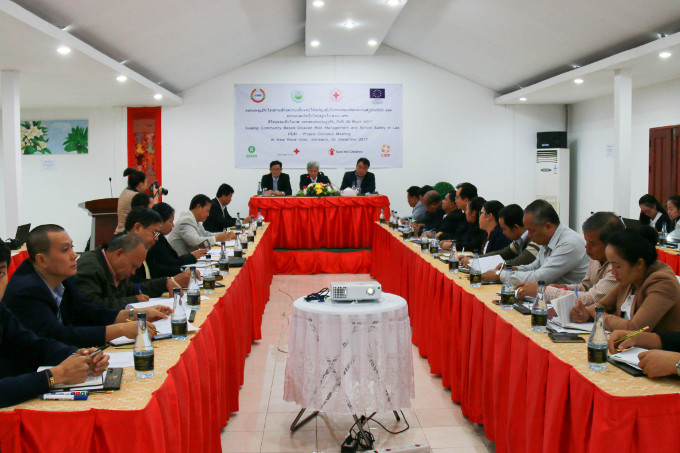Close Out Meeting of the Scaling Community Based Disaster Risk Management and School Safety Project in Lao PDR

December 26th, 2017 - officials from the Lao Red Cross, Ministry of Labour and Social Welfare, and the Ministry of Natural Resources and Environment together with the consortium of Care International, the French Red Cross, and Save the Children Internationalgathered to conclude a 2-year project (2016-2017) on disaster preparedness in Sayaboury, Vientiane, Sekong, and Khammoun provinces.
The Community Based Disaster Risk Reduction Management (CBDRM) Phase II is a project funded by the European Union Directorate General for Civil Protection and Humanitarian Aid (DIPECHO) to increaselocal authorities’ capacity and strengthen strategies for disaster management at provincial, district, and village levels. The project trained officials responsible for disaster preparedness and response in communitiesinidentifying vulnerable areasand populations who are prone to risks, and in developing plans for mitigating risks. They were also supported in putting together their response plans at community, district, and provincial levels in the event of natural disasters.
The closeout meeting was co-chaired by Dr. Kaviphone Southy, Director of the Disaster Management Department of Lao Red Cross and Mr. Kindavon Luangrath, Director of Disaster Management Division of the Social Welfare Department, with Mr. Vilasack Virapanh, Deputy Country Director of Save the Children International.

During the meeting, consortium representatives and provincial and district authorities from Sayaboury, Vientiane, Sekong, and Khamoun provices shared results and lessons learned from CDBRM project implementation. Participants also shared their visions for the way forward for CBDRM in Laos. The government recognizes that natural disasters in Laos are made worse by climate change.
Community level disaster risk mitigation and response plans have been developed in a total of 95 villages in 9 districts in the four provinces. Knowledge and skills on immediate disaster response among village and district officials have been built in these areas and the challenge now for provincial authorities is how to sustain and scale up the work to cover other districts and villages not covered by the pilots. The remoteness of many villages and the limitations of radio communications delay disaster warnings and incidence reporting between the provincial and district office and the villages. Disaster Risk Reduction Trainers from the MoLSW, MONRE, and Lao Red Cross are prepared and can potentially continue to work to expand disaster risk reduction in the country.


 Laos
Laos